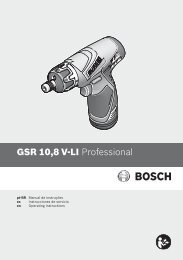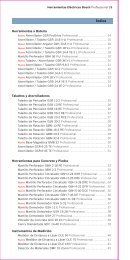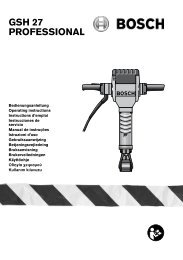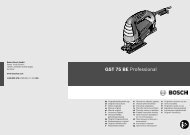GST 85 PBE PROFESSIONAL
GST 85 PBE PROFESSIONAL
GST 85 PBE PROFESSIONAL
You also want an ePaper? Increase the reach of your titles
YUMPU automatically turns print PDFs into web optimized ePapers that Google loves.
Recommendations:<br />
– The more narrow and clean the cutting edge<br />
should be, the lower the pendulum action level<br />
should be selected (or switched off).<br />
– For thin materials, e. g. sheet metal, switch the<br />
pendulum action off.<br />
– For hard materials, e. g. steel, work with low<br />
pendulum action.<br />
– For soft materials and when sawing in the direction<br />
of the grain, work with maximum pendulum<br />
action.<br />
The optimal setting can be determined by practical<br />
testing.<br />
Adjusting the Cutting Angle<br />
(see figure A )<br />
After loosening the screw 14 and sliding lightly<br />
forward in the direction of the saw blade, the base<br />
plate 8 can be swung to the right or left to a maximum<br />
of 45°.<br />
After coarse adjustment, tighten the screw 14 so<br />
that the base plate 8 can still just be adjusted.<br />
The cutting angle can be pre-adjusted by means<br />
of the scale for mitre angles 13. Precise adjustment<br />
with use of a commercial angle gauge 15 is<br />
recommended.<br />
Then tighten the screw 14 again.<br />
To achieve precise cutting angles, the base plate<br />
is fitted with a locking device at 0° and 45° (left<br />
and right). For this, however, the base plate must<br />
be pushed back (towards the motor) to the stop,<br />
so that the notch in the base plate engages in the<br />
positioning pin 17.<br />
When returning the base plate to the 0° (normal)<br />
position, press the base plate lightly in the direction<br />
of the motor until it can be felt to engage and<br />
again tighten the screw 14.<br />
Offsetting the Base Plate<br />
(see figure B )<br />
For sawing close to edges, the base plate can be<br />
offset to the rear:<br />
Use Allen key 5 to take out screw 14 completely.<br />
Lift the base plate and move it to the rear such<br />
that the screw can be turned into the rear thread.<br />
When tightening the screw 14, the base plate<br />
must be pressed to the rear until it can be felt to<br />
engage.<br />
– With the base plate offset, only the 0° (normal)<br />
position can be used.<br />
– The circle cutter/parallel guide 19 as well as the<br />
splinter guard 18 cannot be used in this case.<br />
Splinter Guard (see figure C )<br />
To avoid fraying of the surface, install the splinter<br />
guard 18 by pressing it into the base plate 8.<br />
The splinter guard cannot be used for certain saw<br />
blade types (e. g., saw blades with set teeth).<br />
Tips<br />
■ When sawing small or thin workpieces, always<br />
use a firm support or a saw table (accessory).<br />
For tight curves it is best to use a narrow saw<br />
blade.<br />
When sawing metal or similar materials, apply<br />
coolant/lubricant alongside the cutting line.<br />
Circle Cutter/Parallel Guide<br />
(Accessories – see figures D – E )<br />
With the combined circle cutter/parallel guide 19,<br />
circular cutouts or parallel cuts in materials of up<br />
to 30 mm thickness can be made.<br />
Plunge Cutting (see figures F – G )<br />
Plunge cuts may only be applied to soft materials,<br />
such as wood, aerated concrete, gypsum<br />
plaster boards, etc.!<br />
Place the machine with the front edge of the base<br />
plate on to the workpiece and switch on. Firmly<br />
hold the machine against the workpiece and by<br />
tilting the machine, slowly plunge the saw blade<br />
into the workpiece.<br />
When the base plate fully lays on the surface,<br />
continue sawing along the cutting line.<br />
Maintenance and Cleaning<br />
■ Before any work on the machine itself, pull the<br />
mains plug.<br />
■ For safe and proper working, always keep the<br />
machine and its ventilation slots clean.<br />
■ In order to avoid operational malfunctions, do<br />
not saw gypsum board from below or overhead.<br />
In extreme working conditions, conductive<br />
dust can accumulate in the interior<br />
of the machine when working with metal.<br />
The protective insulation of the machine<br />
can be degraded. The use of a stationary<br />
extraction system is recommended in<br />
such cases as well as frequently blowing<br />
out the ventilation slots and installing a<br />
residual current device (RCD).<br />
10 • 1 619 P01 997 • TMS • 23.03.06<br />
English - 5








